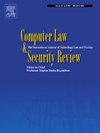我的人工智能,我的代码,我的秘密——欧盟人工智能责任指令提案下的商业保密、信息透明度和有意义的诉讼参与
IF 3.2
3区 社会学
Q1 LAW
引用次数: 0
摘要
在欧盟(EU)法律中,人工智能责任指令(AILD)提案包括高风险人工智能系统造成伤害的受害者有权要求披露相关证据。然而,这种权利受到商业秘密保护的限制。在法律诉讼过程中,商业保密确实会限制受害者获取证据的机会,可能使他们无法充分了解有争议的事实,无法在法庭上有效地表达自己的观点。本文考察了《商业秘密保护法》是否提供了足够的程序机制,以确保诉讼当事人能够有效地参与司法程序,即使由于合法的商业秘密保护,关键证据被扣留。我们的分析借鉴了新兴的全球人工智能责任案件中突出的证据挑战,并精选了欧洲法院判例法,这些判例法为如何在合法保密和可行的信息透明度水平之间取得平衡提供了指导,这是明智和公平解决未来人工智能责任纠纷所必需的。本文章由计算机程序翻译,如有差异,请以英文原文为准。
My AI, my code, my secret – Trade secrecy, informational transparency and meaningful litigant participation under the European Union's AI Liability Directive Proposal
In European Union (EU) law, the AI Liability Directive (AILD) proposal included a right for victims of harm caused by high-risk AI systems to request the disclosure of relevant evidence. That right is, however, limited by the protection of trade secrets. During legal proceedings, business confidentiality can indeed restrict the victims’ access to evidence, potentially precluding them from fully understanding the disputed facts and effectively making their views known before a court. This article examines whether the AILD provided sufficient procedural mechanisms to ensure that litigants can effectively participate in judicial proceedings, even when critical evidence is withheld from them, due to legitimate trade secret protections. Our analysis draws on the evidentiary challenges highlighted in emerging global AI liability cases and selected CJEU case law, which provide guidance on how a balance can be struck between legitimate confidentiality and a workable level of informational transparency, necessary for an informed and fair resolution of future AI liability disputes.
求助全文
通过发布文献求助,成功后即可免费获取论文全文。
去求助
来源期刊
CiteScore
5.60
自引率
10.30%
发文量
81
审稿时长
67 days
期刊介绍:
CLSR publishes refereed academic and practitioner papers on topics such as Web 2.0, IT security, Identity management, ID cards, RFID, interference with privacy, Internet law, telecoms regulation, online broadcasting, intellectual property, software law, e-commerce, outsourcing, data protection, EU policy, freedom of information, computer security and many other topics. In addition it provides a regular update on European Union developments, national news from more than 20 jurisdictions in both Europe and the Pacific Rim. It is looking for papers within the subject area that display good quality legal analysis and new lines of legal thought or policy development that go beyond mere description of the subject area, however accurate that may be.

 求助内容:
求助内容: 应助结果提醒方式:
应助结果提醒方式:


